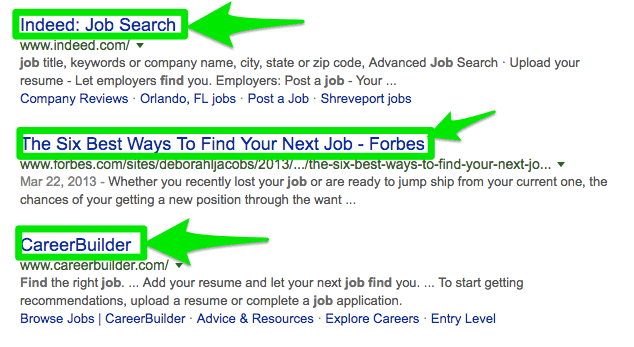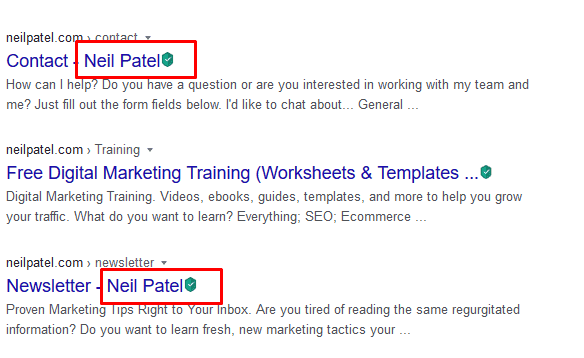An In-Depth Guide to Optimize Page Titles (Best Practices With Examples)

Search Engine Optimization (SEO) is a combined effort of several crucial factors. If you want your SEO practices to work and attain the desired results, you need to consider every small SEO factor. One such factor, which is often overlooked by the majority of people is writing SEO-friendly titles.
The title is an important part of any website. It is the first thing that a user notices about your website, even before landing upon the web page itself. In fact, Moz has ranked the title as the second most important on-page element of every website.
When it comes to optimizing SEO titles, you need to focus on two important perspectives.
- Writing titles that attract your target audience as it will increase the click-through-rate (CTR). And CTR is one of the major Google Ranking Factors
- Writing titles which are search engine friendly so that Google can index and rank your web pages for the target keyword.
It is worth noting that your title must be optimized for both your target audience and the search engine.
You can’t expect your web pages to rank higher if you have only optimized the title for your audience. Similarly, you can’t expect the customer to click on the web page if it has a boring title, regardless of the fact it is optimized for the search engine.
If you have ever gone through on-page optimisation information, you must have read about the significance of optimizing meta titles and writing SEO-friendly titles. However, many people still struggle to optimize the titles, and therefore, never achieve expected results.
So, in this blog post, we are going to help you get better at writing the perfect title for your web pages by sharing effective SEO titles optimization techniques. These guidelines will help you optimize the title for both the search engine and the target audience.
What is the Page Title Tag?
In case you’re new to the SEO world and aren’t familiar with what the page title is, here’s a quick glimpse on the title tag.
Each web page has a specific meta title and meta description. You can consider title as the main headline for the web page, which appears on the SERP only. When a web page is displayed in Google search results, the blue-colored linkable text is the meta title for the particular web page.
The highlighted text, in the above snippet, shows the title tag for the particular page. So, when a user performs a search for the best hotels in New York and sees this particular search result, he is more likely to click it, due to high relevance to the search query itself.
The search engine, on the other hand, would use the title tag to relate the web page to the specific search query and rank it accordingly. In both cases, the title tag helps the search engine and the user understand what the web page is all about. So, it is important to write highly optimized title tags.
There are many people who misinterpret the meta title with the page heading. Even though one can use the same title and page heading, it is important to understand that both these metrics are completely different and serve a different purpose. The page heading is inserted within the H1 tag while the title tag is used under the <head> tag in the HTML code.
The page heading tag, however, is displayed at the top of the web page itself. It doesn’t appear on the SERP. The title tag, as we mentioned, can be kept the same as the H1 tag and one can also use a different title.
In the above blog, Ahrefs has used the same title tag and page heading tag for their blog. However, you can also use a different headline to mention these two metrics like Brian Dean from Backlinko has done with the following web page.
How to Perform Title Tag SEO-Best Practices?
Now, that you know the difference between a title tag and the H1 tag, let’s dive into the best practices to write search engine friendly titles.
Write Unique Title for Each Web Page
Search engine crawler has to differentiate your web pages to understand the context of each web page individually. When you use the same title for multiple web pages, things can get a little complicated for the crawler, which may even harm indexing and ranking these pages. To avoid such circumstances, you must use a distinct title for each web page.
Before writing the page title, take a look at the content you have published on the web page. This will help you write a more informative title, which best describes the page content.
Title Should Describe the Page Content
The page title should describe the web page. Since the main purpose of the title is to explain the page content, it is important that it should be relevant and descriptive. There’s no point in writing titles which have no significance to the page content as it is only going to damage your website rankings.
Suppose you have written a completely irrelevant title, which has no relation to the page content whatsoever. Now, even if you manage to rank in the top positions, the visitors are going to return back to SERP soon after realizing the page cannot resolve their query.
Google’s algorithms are smart enough to track this kind of behavior patterns, and if this continues for long, you may witness a severe downfall in your search engine rankings.
So, to avoid such a scenario, you must keep the title as descriptive and as relevant as possible. The best way to do this is to write 3-4 variants of the title and pick the most suitable one, which best describes the particular web page.
Title Tag Length Should Not Exceed 70 Characters
The best way to captivate your audience through the title tag is to write short and informative titles. As of the recommended SEO practices, the title tag should not exceed 70 characters. In case you have written a lengthy title, Google will automatically shorten it, and it may look something like this.
Now, since the title tag length is more than 70 characters, Google automatically cut its last portion. As a result, the title doesn’t convey a proper idea and it also doesn’t appear to be captivating.
The following title, on the other hand, is less than 70 characters and therefore, looks more appealing and informative.
So, while writing the meta title, make sure to keep its word length less than or 70 characters. Basically, you would want to keep the title short and descriptive.
Note: If you want to know how a particular tool would appear on the search engine, use Moz’s Title tag preview tool. It is quite a handy tool which lets you preview the title tags before publishing.
Simply write down your title in the given text box and hit the check button.
Add Your Target Keyword to the Title Tag
Keywords are the main pillar of SEO. By adding specific keywords to your content, you let your target audience know about the existence of your website. Keywords help you rank for specific search queries as well. Therefore, it is important to infuse your content with the target keyword, whenever possible.
It also means that you should add your target keyword to the title. A well-optimized title must always contain the target keyword as it helps in improving your search engine rankings. When your meta title has the target keyword, it helps both the search engine and customer understand the context of the web page. So, always make sure that your title has the target keyword.
However, you must remember that the title should not be stuffed with the target keyword. Keyword stuffing is the biggest SEO mistake which harms your website performance in many ways. As long as your title has the main target keyword, you’re all set to go.
Keep User Intent in Mind
While it is important to optimize the title for both the search engine and the customer, you must always prioritize the user intent over the search engine. It doesn’t mean that you should completely ignore the search engine, though. It is important that your titles encourage the user to click the link, as that’s the only way to increase CTR and drive more organic traffic to the website.
Follow these practices to write customer-centric titles.
Add Emotional and Appealing Words
Studies suggest that titles having emotional words are more likely to engage the customers. Words such as Amazing, Excellent, Definite, Effective, etc. easily catch the user’s attention. As a result, visitors click the link, which eventually leads to improved CTR.
Among these two titles, the first one is more likely to attract user’s attention, all thanks to the word ‘NEW’ in the bracket.
End Title With Brackets
Another way to make your titles more appealing for your audience is to end them with brackets. Take a look at the above snippet once again and check that it the title has a bracket at the end. This again is one of the good SEO title examples as it makes the title more appealing, thereby improving the overall CTR.
Should You Add Brand Name in Your Title or Not?
This is one of the questions with no specific answer. It mainly depends on your brand popularity. If you’re a well-known brand in your niche, feel free to add the brand name in your title tag. Neil Patel, for instance, always adds his name at the end of every title.
However, considering Neil’s brand authority, he doesn’t need to optimize the titles for the search engine. Each of his blogs is likely to rank in top positions as soon as it gets published. But, if you’re performing SEO for Small Business, you can’t afford to take this risk. So, avoid adding the brand name in the title tag.
Note: If you’re performing homepage SEO, however, you’re free to add the brand name in the title as this will increase your brand authority.
SEO Title Examples (Best Practices)
Now, that you know how to optimize the title tag, let’s take a look at some of the examples where people have written the most suitable titles for their web pages.
As you can see that the title has content inside the bracket at the end, which is extremely appealing. Moreover, considering Ahrefs’ brand authority, they have also added the brand name in the title.
Title Tag Best SEO Practices – A Quick Recap
Here’s a quick recap of all the title tag practices we have discussed so far.
- Try to write distinctive titles for each web page on your website. Duplicate titles make it difficult for the search engine crawler to index and rank your pages.
- Keep the title length below 70 characters. Do not write lengthy titles as Google has a habit of shortening them, which may not appear as clear as you wanted them to be.
- Add your target keyword to the title and make sure to keep it at the beginning. However, avoid keyword stuffing as it can drastically damage your website performance.
- Make sure to write descriptive titles which, despite being concise, clarifies what the web page is all about.
- Improve your CTR by adding emotional words to your page title. They make the title more appealing and are more likely to be clicked by the customer.
Final Words
Title tag optimization is a crucial part of on-page optimization. Apart from helping you captivate the target audience, page titles also improve the CTR for the particular page, which thereby increases your search engine rankings. However, you can’t win the entire battle simply by optimizing the page title for each web page.
You need to focus on several other factors as well. Like we mentioned earlier, SEO is a combined effort of several crucial factors and you can’t expect to achieve desired results simply by optimizing the page title.








